So, I’m not the world’s biggest Quentin Tarantino fan, or, for that matter, what you might call a fan at all. I find every one of his films a hodgepodge of ideas and styles, some of them brilliant, more of them patently absurd. There’s no doubting his place in or contributions to film history: as a writer, director, curator, producer, he’s had a profound influence on more than one generation’s understanding of world cinema and made two fistsful of the buzziest, brashest films of his era. And while I never leave a Tarantino film feeling fully satisfied, in each of them I will find myself for a while wholly, intensely immersed in the small, intimate worlds he creates, elaborate fictions set in alternate realities that provide ample occasion to reflect on the real worlds they mirror.
Tarantino’s 2019 opus Once Upon a Time… in Hollywood is a film rife, to my thinking, with the kind of absurd spectacle that ultimately derails its narrative progress. Others, I know, may think that torching Manson-family minions aflame might provide a cathartic alternative-universe conclusion to the gruesome reality of the Tate-LaBianca murders they committed fifty years prior. Personally, I just find it … silly, a sophomoric exercise in thoughtless slapstick violence, a cartoonish montage of head butts, crotch bites, and immolations. I sympathize with those who find Tarantino’s portrayal of the late Bruce Lee unnecessarily arrogant and designed only to characterize Brad Pitt’s stuntman’s fighting prowess.
But along the way towards its explosive counter-conclusion are dozens of thoughtfully staged, brilliantly shot, and perfectly acted scenes that recreate a Hollywood of 1969 where television and film vie for viewers’ attention and Leonardo DiCaprio’s aging Western star Rick Dalton hopes to salvage what is left of his career. Hired to play the heavy—itself now a bad omen, one step further from stardom—on the new TV series Lancer, Rick must channel his thespian talent even when unnerved by the show’s production. Recreating the set of Lancer, Tarantino works his ineffable magic, immersing viewers in his world-within-a-world, providing his talented cast room to shine and his production team an opportunity to recreate an Old West as New Hollywood had made it some 50 years ago.
Here’s the setup: Rick, formerly the star of Bounty Law, is hired to guest-star on the pilot episode of Lancer, a multigenerational familial melodrama Western series in the mold of a Bonanza or Big Valley—but without the big stars or Nielsen numbers—as Caleb DeCoteau, a long-haired gunslinger and extortionist hoping to swindle family patriarch Murdoch Lancer. His character, coiffed and garbed in styles unfamiliar to Rick, will have scenes with series regulars James Stacy, played by Timothy Olyphant; Wayne Maunder, played by the late Luke Perry; and Trudi Frazer, played by Julia Butters. It’s all pretty straightforward, except that Dalton’s late-night rehearsal regimen of a blenderful of swimming-pool whiskey sours isn’t doing his aging memory or puffy face any favors. Nor is the absurdly stylized patois of the villainous dialogue scripted for him.
Everything about the set is, to Rick, well established as the film’s primary point-of-view character (along with, to lesser extents, Margot Robbie’s Sharon Tate and Pitt’s Cliff Booth), disorienting. The actor needs help to find wardrobe, where his sartorial style is reworked by director Sam Wanamaker (Nicholas Hammond) to the new modern of the medium and waits uncomfortably alongside young Trudi (the awesomely self-possessed Butters), one of his scene partners. An idle conversation with the young actor, ostensibly about the dime Western Rick passes his time reading, triggers the actor’s self-doubt to the point of tears.
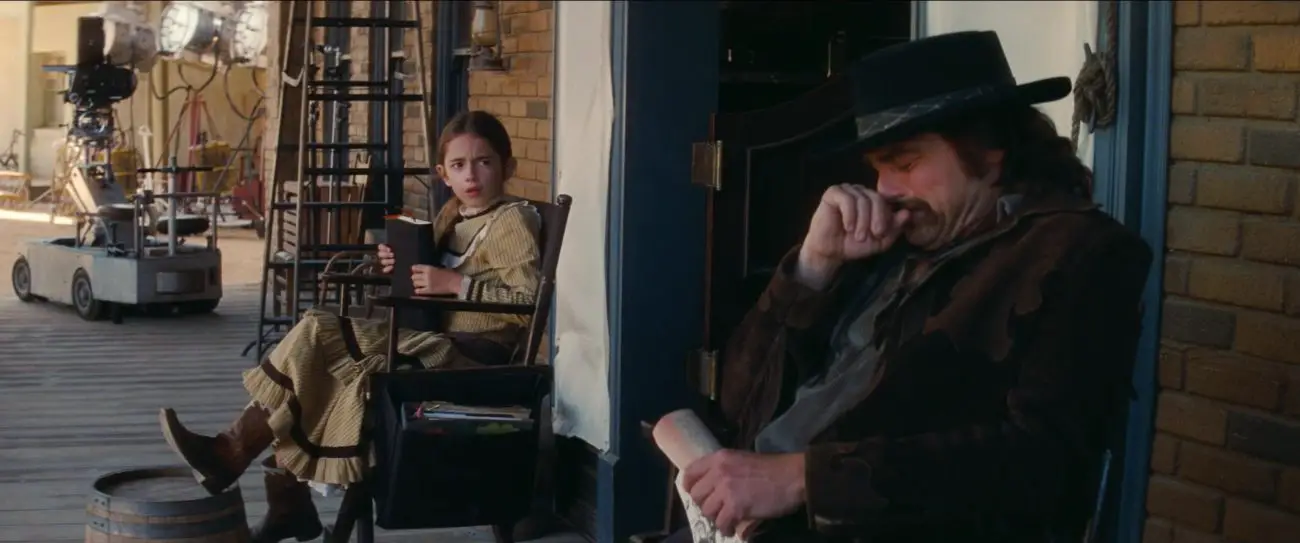
One of the longest, most languorous, and to my thinking, most effective of Once Upon a Time… in Hollywood’s scenes then takes place when Rick’s Lancer character Caleb meets with gunslinger Johnny Madrid (Olyphant), one of the Lancer patriarch’s two initially-estranged sons. Exactly at the film’s midpoint, the scene is set in a dusty saloon run by a Mexican proprietor. No indication of the fact that the scene is being shot by a crew is visible or even audible: there are, in our view as the audience, no mics or booms, lights or cables, clapperboard or crew or even director guiding the scene. It’s shown, rather—and quite curiously at that—as a fully-formed, finished episode of Lancer itself.

Or, that is, as an elegant, sophisticated, widescreen reenactment of a Tarantino-directed Lancer episode, shot in high-definition Kodak 35mm film using Panavision cameras and lenses. It’s what the prior scene, where Johnny guns down “Business Bob” Gilbert in the street, does: recreates not the in-process production of Lancer Rick is actually experiencing that day but instead Tarantino’s postmodern conception of the imagined finished product, replete with a variety of low and wide angles and extreme close-ups, almost as if the Spaghetti-Western sensibilities of a Sergio Leone or Corbucci had filtered through.
A more conventional take on this Lancer episode remake might have framed the shot in the then-television-standard 4:3 aspect ratio. Or it might have included the offscreen sounds of pre-take on-set hubbub or partial shots reminding the audience of the presence of crew and gear. In fact, that’s what many films about Hollywood itself, from The Stand-In and A Star Is Born through, say, Singin’ in the Rain and The Bad and The Beautiful up to Hail! Caesar and the recent Hollywood Fringe will do: reveal, foreground, and emphasize the artifice of the situation by highlighting the mechanics of its production.
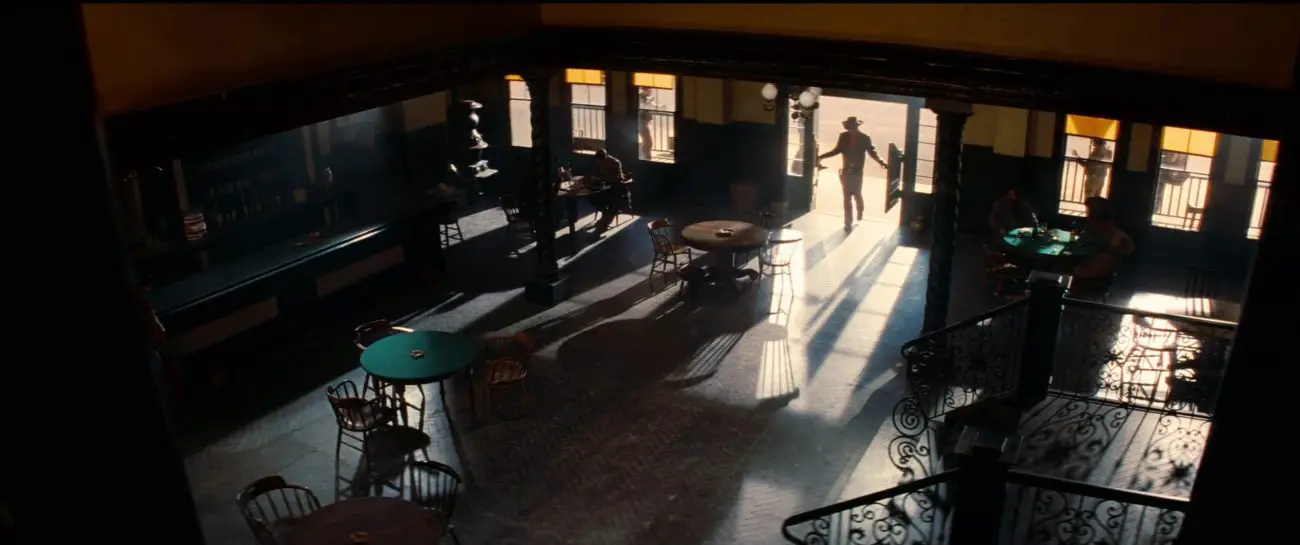
Yet Tarantino’s choice here is the exact opposite, and the resultant effect is absolutely immersive. From the moment Olyphant as James Stacy playing Johnny Madrid enters the saloon, the cinematography and editing resemble that of a finished feature, the illusory product of Hollywood’s messy, tangled, and typically unseen processes. The first shot is a master of the nearly-empty saloon, shot from high and above, a position we’ll later learn is Caleb’s. No sign of any cameras, gear, or crew are to be found anywhere. The next frames Johnny (I’ll use their Lancer character names) in full centered close-up as he approaches the camera: just moments before, he’d killed a man outside the saloon doors, niftily nailing his mark with a single behind-the-back shot. Johnny, like any good gunslinger, warily surveils the saloon before setting eyes on the man he is there to meet.

As Rick’s Caleb DeCoteau melodramatically makes his appearance from the top of the stairs (is he Joan Crawford’s Vienna in Johnny Guitar?), the camera delicately glides alongside and behind him, then, from the main level, dollies out and away, giving the character plenty of space. “Johnny Madrid,” he announces, lighting a cigarette. The two agree to a drink and reminisce about a gunfight in Juarez. At the bar, Johnny’s smoke, the filtered sunlight, and a thousand motes of dust create a richly elegant chiaroscuro: it’s not really like anything ever seen in the far more pedestrian, utilitarian setups of the actual 1968-70 CBS series Lancer. But more to the point, the scene is again, fully finished and edited for continuity, a conceit that pulls us further into the world of Lancer’s characters—and not those of Once Upon a Time in… Hollywood. This dialogue is between Caleb DeCoteau and Johnny Madrid, two men who appear as equals, and with a shared history.

But Caleb is the episode’s heavy, as they say, and the scene’s dialogue works to characterize him as such. As the two men sit at their table with their bottle of Mezcal, the two-shot framing sets them as equals. For the first time, as they discuss their mutual goal—money—a few soft notes of a gently plucked vihuela can be heard. There is no apparent source of the music and it seems as if it’s nondiegetic, the kind a television episode might add in postproduction. Curiously, moments after this music, something almost impossible to the actual on-set production, is heard, Caleb slaps the barkeep’s arm and asks: “Hey! Where’s that chili-pepper daughter of yours with the fiddle? Wake her the heck up, get her down here with her fiddle and her bow, and entertain my guest!”

The barkeep responds: “Sí. Please, don’t hurt her this time.” So: Caleb is indeed the heavy, a man prone to abuse of women (and harangue of servers, for that matter). He spits out his drink. The camera cuts to a traditional over-the-shoulder shot/reverse-shot position, with a pulled focus from Johnny to Caleb, again more evidence of the finished, edited, highly stylized quality of the scene: “I ain’t gonna hurt her. I just want her to play the fiddle,” he fumes. And stalls. Abruptly, impossibly, the gentle strum of the vihuela halts, on cue. For the first time in more than three minutes, Tarantino reveals the scene as an elaborately constructed fiction: Rick Dalton, hung over and tongue-tied, calls “line.”
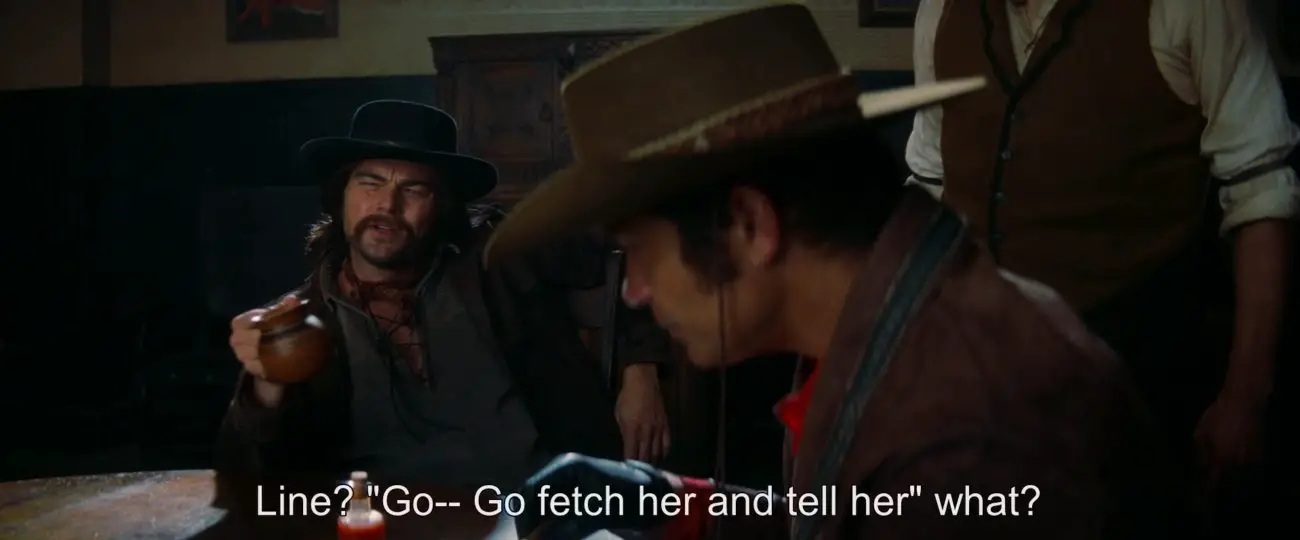
The spell is broken, if only temporarily. Offscreen, an unseen AD provides the line, and Rick manages to bumble it out. “Now go fetch her and tell her I’ll give her a fat five-dollar gold piece if she plays her little chili-pepper heart out.” The second he does, the soft pluck of vihuela reappears, perfectly punctuating his delivery. Johnny and Caleb continue their assessment, the camera glides around behind the two of them, and as Caleb leans forward and glowers, the music clumsily stops, and Rick loses the script once more: “God damn, I f*cked this whole thing up, Sam!” he bellows.
James Stacy is unperturbed, but Rick Dalton is a mess. “Can we please just cut?” The camera glides back, retracing its path behind their table, and the process restarts: Stacy re-delivers his last line with a rote, calm professionalism. Humiliated but determined, Rick glowers his way through the end of the scene, which concludes with a smash-cut to his later throwing a tantrum in his trailer.
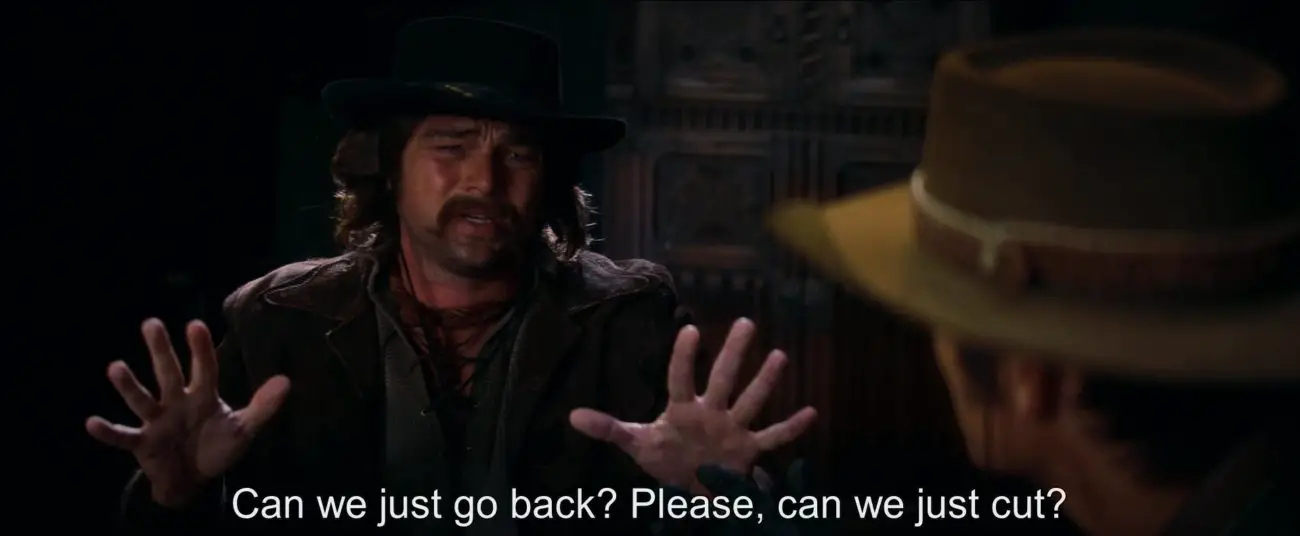
During this longer middle act of Once Upon a Time… in Hollywood, Tarantino cross-cuts between Rick’s day on the set of Lancer, Cliff’s picking up Manson-minion hitchhiker Pussycat (Margaret Qualley) and Sharon’s trip to watch herself onscreen in her new release The Wrecking Crew. After his jump-cut trailer tantrum, Rick settles into his next Lancer scene with little Trudi and the “refined” Lancer son Scott, where he performs admirably, earning kudos from his director and—even more importantly, though she may be, well …, acting, his young co-star Trudi, who tells him “That was the best acting I’ve ever seen in my whole life.”

Never mind that she is all of eight years old; the compliment moves Rick to tears. “Rick F*ckin’ Dalton,” he exclaims with pride, cocking his prop pistol upwards in a triumphant phallic display of pride.
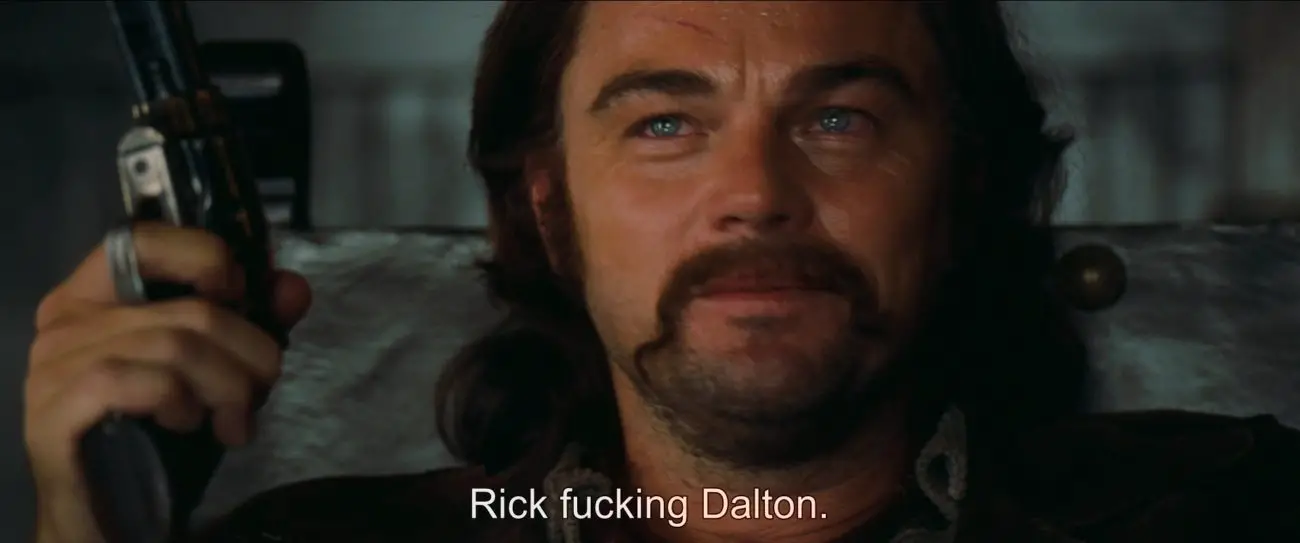
As a television show, the original Lancer was a modest production. Its cast were not big stars, its ratings unspectacular, its content generally unremarkable. Unlike the better-known Westerns of its era like Gunsmoke, it achieved no notoriety for longevity (running only two seasons), nor did it, like The Big Valley, feature big-name studio-era stars like Barbara Stanwyck. Lancer’s pilot, available on YouTube, is nowhere near as cinematically expressive as Tarantino’s recreation, nor is its dialogue as fanciful as Once Upon a Time… in Hollywood’s Caleb DeCoteau’s peculiar patois.
Tarantino’s scene borrows liberally, but not at all faithfully, from the actual Lancer pilot. The television show’s stars were much younger than Tarantino’s: Stacy and Maunder were just into their thirties at time of Lancer’s debut, compared to Olyphant and Perry, both in their early fifties. Stacy and Maunder’s contrasting sex appeal was one of Lancer’s selling points. In the series pilot, the two strangers share a number of scenes together and eventually develop a wary camaraderie. Joe Don Baker is the villain, Day Pardee, on whom the Caleb DeCoteau character is modeled, from his actions to his wardrobe and hairstyle. The scene discussed above is modeled on a shorter interaction between Stacy’s Johnny Madrid and Baker’s Pardee in a saloon, but without, of course, the Tarantino flourishes of colorful dialogue and stylish camera movement so evocative in Once Upon a Time… in Hollywood.

But Lancer’s generic qualities work to Tarantino’s advantage: that it was rarely recalled and infrequently rerun allows him to create from its raw material a set and scenario that is both vaguely familiar and simultaneously fresh and new. In doing so, Tarantino creates from this mundane clay an artful, immersive, set piece and a major step in his protagonist Rick Dalton’s characterization: he can act, even if hung over, even when coiffed and garbed unrecognizably, even in a milieu that has become uncannily unfamiliar to him. And let’s not overlook that DiCaprio is himself playing an especially layered scene, acting as Rick Dalton acting as Caleb DeCoteau. Whatever Tarantino’s excesses as a writer-director, he’s known for his hands-on, highly collaborative, work with his cast. Dalton’s flub, says Tarantino, was DiCaprio’s improvisation.
But what impresses most about this scene is the means by which it so wholly renders the fictional world of Lancer Rick has entered. By avoiding any indication of cast or crew, any intimation of the process of filming until Rick’s flubs, any Tarantino immerses viewers fully in this film within a film, set within a set, a world within a world. His Lancer is a fully-formed, carefully-edited, and spit-polished final version of the finished product, a twenty-first century simulacrum of late-1960s television’s rendering of the 19th-century West. And it’s a treat, the very kind of scene that to my thinking the director does best. He may be best known for explosions, gunfire, immolations, and flamethrowers, but this particular scene, a curious hybrid of careful construction and ad-hoc improvisation tying together the film’s themes of nostalgia and obsolescence, offers its own kind of fireworks.




Categorizing this film as sophomoric is absurd. We are all fortunate to be alive to witness Tarantino’s growth as a filmmaker from Reservoir Dogs til now.
That is an awesome analysis of that scene. The first time I saw OUATIH, when it got the Lancer scene I sort of forgot I was watching a movie about 1969 Hollywood and drifted into this drama-filled western movie. The moment when Rick forgets his line was jarring exit back into reality. After seeing OUATIH at least ten times, I still drift into this western as if it is the movie I am watching.
I totally enjoyed the analysis. I have been a fan of Lancer for 54 years and the characters who stared in the show. While no one can replace James Stacy and Wayne Maunder, Olyphant and Perry were a delight to watch. I wish Tarantino had given us the entire pilot episode but what he did give us was inspired.
Great analysis. Well written.
Thanks, Michael, and appreciate your reading our work here!
Great analysis! I AM a fan, and I think Once Upon a Time may just be my favourite Tarantino yet. Not sure I would like to be stuck in a stalled elevator with him, but boy he can make movies that both entertain and confound.
Thanks, Mark! I don’t think I’ve ever seen a Tarantino film I can get behind 100%, but they give us much to think and talk about. I remember reading Vincent Bugliosi’s book Helter Skelter when I was 15 and I have watched nearly every film-about-Hollywood ever made, so I am really interested in and intrigued by the world he creates here. (Even if I hate the ending.)